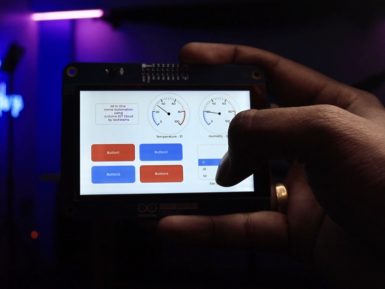
Overview
DFPlayer mini MP3 player is a small and low cost MP3 module player with a simplified output directly to the speaker.
The module can be used as a standalone module with attached battery, speaker and push buttons or used in combination with an Arduino UNO or any other with RX/TX capabilities.
It perfectly integrates hard decoding module which supports common audio formats such as MP3, WAV and WMA.
Besides, it also supports TF card with FAT16, FAT32 file system. Through a simple serial port, users can play the designated music without any other tedious underlying operations.
Application
- Car navigation voice broadcast
- Road transport inspectors, toll stations voice prompts
- Railway station, bus safety inspection voice prompts
- Electricity, communications, financial business hall voice prompts
- Vehicle into and out of the channel verify that the voice prompts
- The public security border control channel voice prompts
- Multi-channel voice alarm or equipment operating guide voice
- The electric tourist car safe driving voice notices
- Electromechanical equipment failure alarm
- Fire alarm voice prompts
- The automatic broadcast equipment, regular broadcast
Tech specs
|
Supported sampling rates (kHz): 8/11.025/12/16/22.05/24/32/44.1/48 |
| 24 -bit DAC output, support for dynamic range 90dB , SNR support 85dB |
| Fully supports FAT16, FAT32 file system, maximum support 32G of the TF card, support 32G of U disk, 64M bytes NORFLASH |
| A variety of control modes, I/O control mode, serial mode, AD button control mode |
| Advertising sound waiting function, the music can be suspended. when advertising is over in the music continue to play |
| 30 level adjustable volume, 6 -level EQ adjustable |
Get Inspired

An interactive polyphonic wavetable synthesiser for the Arduino GIGA & Display Shield

In a previous video about controlling household appliances and lighting fixtures from the Arduino Cloud, Sachin Soni of the techiesms YouTube channel designed a custom PCB that allows an Arduino Nano ESP32 to toggle a series of relays. But since then, he realized that his project needed a faster and more permanent method of getting to the controls, which led him to build a complete home automation dashboard using solely Arduino hardware. Soni opted for the new Arduino GIGA Display Shield since it contains a 3.97” RGB touchscreen with support for up to five simultaneous touch points and an array of sensors if the functionality were to ever be expanded. On the back, an Arduino GIGA R1 WiFi was attached to act as the display’s controller and leverage its Wi-Fi capabilities to communicate with the system’s Arduino Cloud variables. The final step in this project involved creating a software-defined graphical user interface (GUI) complete with toggleable buttons for the lights, dials to indicate temperature/humidity levels, and a way to select the fan’s speed from an array of values. Soni was able to finish most of the groundwork by utilizing the LVGL library and its highly customizable GUI components. After laying out the buttons and dials, synchronizing Cloud variables, and connecting their event handlers to value updates, Soni had a functional tablet that could wirelessly manage his appliances from anywhere.








